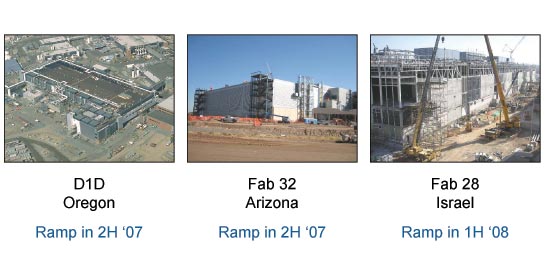Intel Demonstrates new 45nm Transistors and Conroe's Successor
by Anand Lal Shimpi on January 27, 2007 12:00 AM EST- Posted in
- CPUs
Yields and Manufacturing
Intel is sharing its usual vague data on yields at 45nm, but at least this time we get pretty good reference points to previous manufacturing processes. The graph below shows defect density as a function of time; you should keep in mind that processors generally don't start shipping until the very bottom of these curves in order to make the economics work for the CPU maker.

As you can see, 45nm is on a curve very similar to that of Intel's 65nm process, which means that things are on track for a smooth introduction later this year barring any unforeseen issues.
Intel attributed the rough patches in the 90nm trend to difficulty associated with building the first strained silicon transistors and using low-k interconnect dielectrics. By comparison, 65nm and 45nm appear to be much smoother sailing.

By the end of this year the first 45nm chips will be built at two 300mm Intel fabs: D1D in Oregon and Fab 32 in Arizona. Starting in the first half of 2008, Fab 28 in Israel will begin producing 45nm parts and should reach full capacity by the end of the year.
Final Words
It's very rare to get this much information out of Intel this far in advance of an actual product launch, but we're not complaining. By the middle of this year, AMD will launch its next-generation microarchitecture that will hopefully be a far better competitor to Intel's Core 2 processors. But before the year is out, Intel will respond yet again with its Penryn family of processors. We're unsure exactly what segments will be targeted first with Penryn, but by sometime in 2008 you should be able to get Penryn based notebooks, desktops and servers.
The inevitable comparison to AMD's progress on 45nm has to be made, but at this point we don't know too much. AMD revealed its 45nm SRAM test vehicle about three months after Intel did last year, with a slightly larger SRAM cell size (0.370 um^2 vs. 0.346 um^2 for Intel). The main focus for AMD at this point is the transition to 65nm; we're finally starting to see Brisbane cores available for purchase, but the highest clock speed offerings are still built on 90nm.
For Intel, we see continued strengthening and a roadmap that has a lot of promise. Penryn should be out sometime in the second half of this year, followed by a brand new architecture under the codename Nehalem. Nehalem will also be the first time we get to see an architecture change post-Core 2 under Intel's new tick-tock model of introducing new architectures every two years. It's quite possible that in the next two years Intel will have made the CPU industry far more exciting than it has been in the previous five (Core 2 launch withstanding).










59 Comments
View All Comments
mostlyprudent - Saturday, January 27, 2007 - link
Do we have any info as to chipset/socket compatability for Penryn?MarkM - Saturday, January 27, 2007 - link
Whoa Nelly!!! They JUST achieved a first validation sample of the material, what, SIX HOURS AGO? Lord knows when they'll even have chipset details figured out, and a shipping CPU is still a year off.This is a moment to step back and marvel at the continued long term achievement of the semiprocessor industry, not obsess how your going to run Vista!
mino - Saturday, January 27, 2007 - link
Well, AMD stated that K8L will be drop-in compatible with SocketF/AM2 insrastructure in May 2006(if not sooner).That seems pretty much a yer ago from expected shipment date of mid-2007.
This was presented not only to public but also to its corporate customers! ...
To answer the original question:
Do not expect penryn to work with anything older than 965 series of chipsets on boards introduced by 2H07 or later.
mino - Saturday, January 27, 2007 - link
Meaning, ofcourse, that one should not expect penryn to be drop-in compatible with any current boards.Andrwken - Monday, January 29, 2007 - link
Actually, considering they are using unmodified hardware to run the chips. I would be rather surprised if they did not work on any core 2 capable motherboard. Correct me if I'm wrong, but a well researched motherboard purchase could get you a mobo that can run any 775 socket Prescook, Core 2 (dual or quad), and possibly Penryn? That's a pretty good lifecycle for a socket. How many has amd had in the last 2 years?JarredWalton - Monday, January 29, 2007 - link
I believe Penryn is scheduled for launch around the same time as Bearlake, and in the past we have seen a lot of official Intel platforms require a new chipset - whether or not the requirement is strictly necessary is obviously a different story. I believe Core 2 Duo is supposed to "require" P/G/Q965 or 975X, or one of a few select 945/946 chipset versions. Obviously, with 865 and 915 boards out there supporting the new CPUs, Intel's requirement was not strictly necessary, but most boards for C2D still use 965 or 975. What will happen with Penryn? I have no doubt we'll see some 965/975 boards that support it, but I'll be pleasantly surprised if the official requirement doesn't include Bearlake.Viditor - Tuesday, January 30, 2007 - link
I believe that Bearlake is out 3-6 months before Penryn (Q2-3 for Bearlake), but your point is taken...
mostlyprudent - Saturday, January 27, 2007 - link
Sorry for the pragmatic obsessiveness...cannot be helped!MarkM - Saturday, January 27, 2007 - link
No problem, I hope I didn't come off sounding more negative than I meant to be! Anyway I just happened to stumble on a partial answer to your question:http://www.dailytech.com/article.aspx?newsid=5869">linkflyck - Saturday, January 27, 2007 - link
IBM and AMD (who work together) already stated that they have a simular technology, http://www.eetimes.com/news/semi/showArticle.jhtml...">linkSo don't say doomed yet -_-